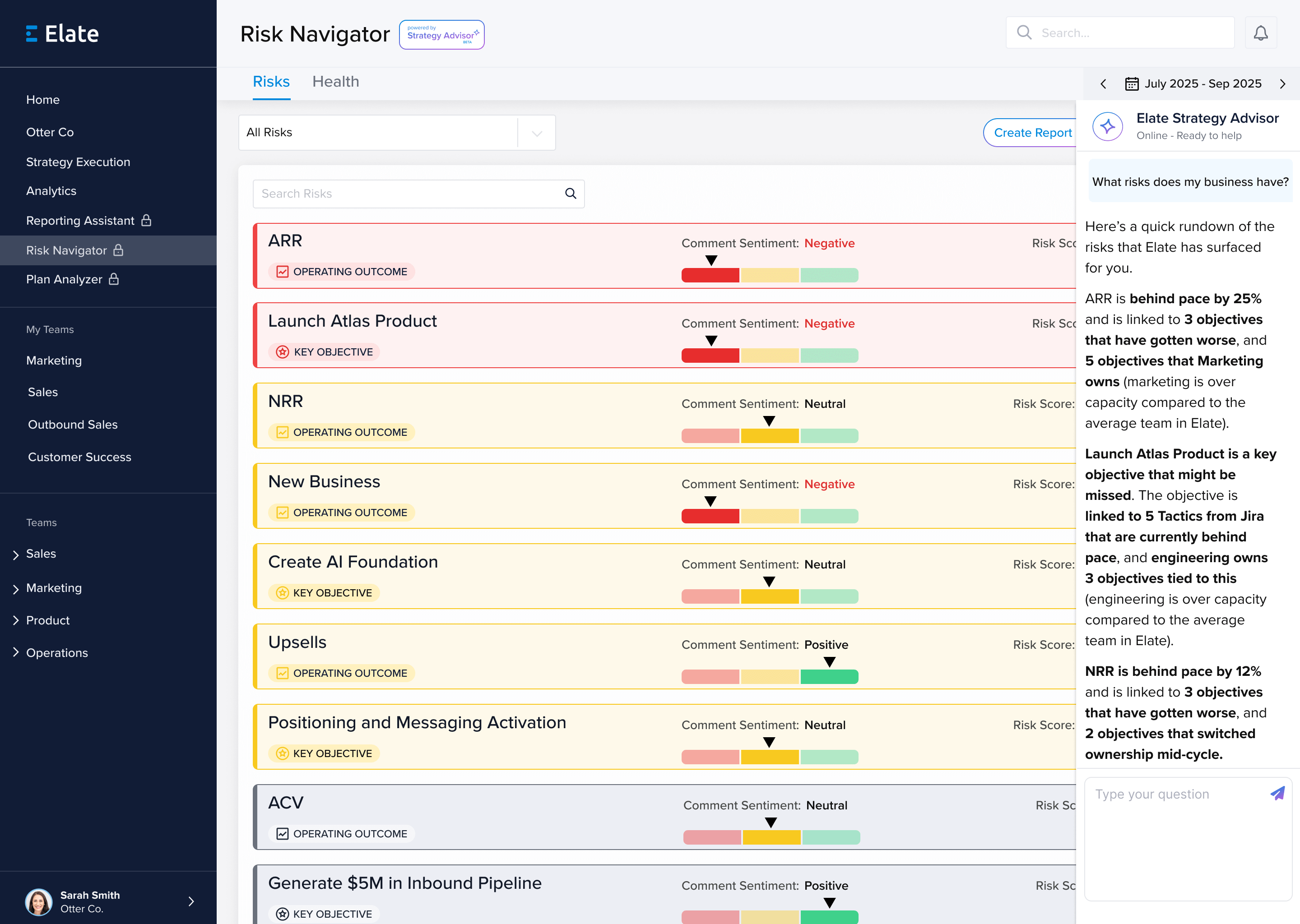The process of implementing an OKR framework across a company can feel like a marathon. From simply educating team members on what OKRs stand for (Objectives and Key Results) to ensuring Objectives have measurable Key Results, strategy and operations leaders understand firsthand the intense lift it requires to implement OKRs.
For many companies, so much time and effort is spent manually creating, communicating, and cascading OKRs that when you finally have an OKR framework in place for that quarter you simply want to catch your breath and forget about OKRs until next quarter.
Not only is that an easy way to lose the momentum of implementing OKRs in the first-place, but it is also a surefire example of why OKRs fail for so many companies.
The process of implementing OKRs for the first time is where the journey begins. The process of executing and effectively running an OKR Meeting is where the value of OKRs begins to compound. For many companies the question of ‘How to Run an OKR Meeting?’ is a simple, yet overlooked part of the overall process.
Today, we wanted to highlight some of the key reasons to prioritize OKR meetings and how to run an OKR meeting at the leadership level.
Build the OKR Check-in to Prioritize What Matters
Similar to John Doerr’s OKR book, Measure What Matters, companies should prioritize the OKR check-in to be reflective of what matters most about the check-in.
Far too often we find that companies spend all of their time in OKR meetings talking about every OKR in unnecessary detail. From providing context solely influenced on how we’re feeling about the OKR check-in at the point in time to getting lost in the cascading OKR hierarchy and OKR review template that we were told to use, so much time is spent going through this poorly built OKR meeting cadence that we never get to the heart of what we should be discussing.
The OKR Check-in should certainly provide us a forum to discuss our company OKRs, but it should also allow us to focus the conversation on OKR reviews and discussion that warrants our time.
We recommend starting by simply going through a quick pulse-check on each company OKR: On Pace, At Risk or Behind. For those At Risk or Behind the simple question at the onset should be, ‘Do we need to add this OKR as a topic?’ If yes, then someone (often the Chief of Staff or COO) adds it as a topic of discussion at the end of the meeting. If not, then we move forward.
However, for certain OKRs that are updated as either At Risk or Behind for three consecutive updates, then they automatically get added as a Topic to inform the team on why the OKR isn’t On Pace.
By creating OKR Topics to review at the end of the meeting this allows us to prioritize and measure what matters most in the business. Especially at the leadership level, there is almost never enough time to discuss every problem or challenge throughout the business. So by focusing our topics on the OKRs underperforming or at risk, we can focus on how we can help get an OKR back on track.
Additionally, this process works best if there is a way for your Leadership Team to visualize the specific performance-based Key Results to understand how each Objective is performing against expectation.
For many companies, this visualization of performance-based Key Results vs KPIs can be a discussion point. At Elate, we believe Key Results and KPIs can coexist in how they allow leaders to get high level understanding of how OKRs are performing without digging into the minutiae of every Team Objective. This is where having an easy, intuitive Company Scorecard can come into play.
Create a Company Scorecard Tied to OKRs
Whether for internal or external reporting, Company Scorecards have been a requirement for high growth companies for years. Often falling to the Strategy and Operations or Finance Leader, the Company Scorecard is often reflected in a manual excel spreadsheet or static dashboard that provides no context on what priorities influence or are impacted by these KPIs.
The OKR framework and any OKR template is designed to turn KPIs into measurable Key Results that track performance associated with company priorities.
However, just as we see company’s fall into the trap of using OKR excel templates or even implementing an OKR tracking tool without any connection to data sources, we also find that companies often build their Company Scorecard in a manual, labor-intensive way.
Not only is this type of Company Scorecard creating a habit of looking at static data that doesn’t truly tell us what’s going on in the business, it also eliminates the value of having real-time OKRs and data that guides decision making.
Whether you are looking to shift resources away from an area or potentially double-down on an investment, the Company Scorecard review in a leadership team meeting can allow you to prioritize your OKR quarterly review in a way that allows a monthly OKR tracking template in Sheets or Word documents to be a thing of the past.
OKR tracking tools aren’t focused on connecting to your team’s data sources to unify Salesforce Key Results, Jira Key Results, or other Key Results that can be automated from the existing data sources your team uses today.
The Elate Scorecard can provide strategy and operations leaders with an OKR Scorecard and Company Scorecard that drives action.
A Clear OKR Review Meeting Agenda
So now that we’ve walked through some of the main structural areas for how to run an OKR meeting, let’s provide a clear OKR review meeting agenda for your team:
1. Review Company Objectives. For many companies, the status is a green, yellow, red with each respectively representing on track, at risk, or behind. For those OKRs that are behind or at risk, the meeting owner could ask whether this is a topic of discussion that needs to be added to the agenda. If so, don't jump immediately into the issue. Instead, add it to your meeting agenda at the end. This allows all of the topics to be prioritized and discussed in order of importance.
2. Not Key Results vs KPIs. Key Results and KPIs. Rather than looking at a static dashboard of every single KPI across your business, build a Company Scorecard that reflects the Key Results of Objectives and your main business KPIs. Similar to Company OKRs, if there is a key result or KPI that needs to be discussed, add it to the list of topics. Usually these Topics help surface the issues or opportunities with an overall OKR. Again, we are all about streamlining issues and discussions to be focused on the main priorities of the business.
3. Prioritize Conversation on Issues and Topics. Finally, we can get to the part where we discuss the Issues and Topics facing our business for the week. Not only can these be added throughout the meeting, but they can also be added over the course of the week by any team members. However, it's important to prioritize all of the topics/issues in a way that focuses on the main priorities of the business. You might not get to every topic/issue, and that's alright. They can either move to the following week or if needed another meeting can be set up to specifically discuss those topics/issues.
4. Recap with an OKR Weekly Report. For most companies, this is how you really keep your OKR framework top of mind. Whether you'd like to tailor your OKR weekly report towards the leadership team or even build an OKR weekly report for all employees, it helps ensure there is constant alignment and focus on the priorities moving the business forward. For many leading companies, these reports can be automated with leading Strategic Planning solutions like Elate to help create consistency and save time.
These are four easy steps on how to run an OKR meeting, tailored towards helping team members accurately update OKRs and provide meaningful context.
The Best Strategic Planning Platform Built for Your Leadership Meetings
As Strategic Planning and Execution becomes a competitive advantage for high growth companies, it is becoming more common for companies to embrace goal-setting frameworks to help drive execution towards a company's overall Strategic Plan.
As strategy and operations leaders take on more responsibility in building the framework for driving strategic planning and execution, it is critical that they have the right solution to bring a goal-setting framework like OKRs to life.
Meet Elate.
Elate is the leading Strategic Planning software built to help high growth companies communicate their vision, create alignment, and track performance all in one place.
If you’d like to learn more about how we are working with leading strategy and operations leaders to prioritize how they run an OKR meeting, then feel free to reach out to our team. We'd love to share more about how Elate can help scale your company and provide your team with a solution to turn your OKR framework and OKR meeting into a competitive advantage.











